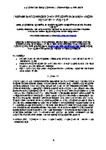High-efficiency gravel longshore sediment transport and headland bypassing over an extreme wave event
| dc.contributor.author | McCarroll, Jak | |
| dc.contributor.author | Masselink, Gerd | |
| dc.contributor.author | Wiggins, Mark | |
| dc.contributor.author | Scott, Tim | |
| dc.contributor.author | Billson, O | |
| dc.contributor.author | Conley, Daniel | |
| dc.contributor.author | Valiente, NG | |
| dc.date.accessioned | 2019-07-09T10:16:20Z | |
| dc.date.available | 2019-07-09T10:16:20Z | |
| dc.date.issued | 2019-06-29 | |
| dc.identifier.issn | 0197-9337 | |
| dc.identifier.issn | 1096-9837 | |
| dc.identifier.uri | http://hdl.handle.net/10026.1/14614 | |
| dc.description.abstract |
<jats:title>Abstract</jats:title><jats:p>Gravel beaches are common throughout the high latitudes, but few studies have examined gravel transport rates, in particular at high energy levels, and no studies have quantified gravel transport around headlands. Here, we present the first complete sediment budget, including supra‐, inter‐ and sub‐tidal regions of the beach, across multiple headland‐separated gravel embayments, combined with hydrodynamic observations, over an extreme storm sequence, representing at least a 1‐in‐50‐year event. Unprecedented erosion was observed (~400 m<jats:sup>3</jats:sup> m<jats:sup>−1</jats:sup>, −6 m vertical), with alongshore flux of 2 × 10<jats:sup>5</jats:sup> m<jats:sup>3</jats:sup>, equivalent to annual rates. Total system volume change was determined to the depth of closure and then used to calculate alongshore flux rates. Alongshore wave power was obtained from a wave transformation model. For an open section of coastline, we derive a transport coefficient (CERC formula) of <jats:styled-content><jats:italic>K</jats:italic><jats:sub><jats:italic>Hs</jats:italic></jats:sub></jats:styled-content> = 0.255 ± 0.05, exceeding estimates in lower‐energy conditions by a factor of 5 or more. We apply this coefficient to rocky segments of the shoreline, determining rates of headland bypass from 0 to 31% of potential flux, controlled by headland extent and toe depth. Our results support the hypothesis that gravel is transported more efficiently at higher energy levels and that a variable rate or threshold approach may be required. Complete coverage and varying morphology make this dataset uniquely suited to improving model predictions of gravel shoreline change. © 2019 John Wiley & Sons, Ltd. © 2019 John Wiley & Sons, Ltd.</jats:p> | |
| dc.format.extent | 2720-2727 | |
| dc.language | en | |
| dc.language.iso | en | |
| dc.publisher | Wiley | |
| dc.subject | storm response | |
| dc.subject | embayed beach | |
| dc.subject | reflective beach | |
| dc.subject | sediment budget | |
| dc.subject | beach morphodynamics | |
| dc.title | High-efficiency gravel longshore sediment transport and headland bypassing over an extreme wave event | |
| dc.type | journal-article | |
| dc.type | Journal Article | |
| plymouth.author-url | https://www.webofscience.com/api/gateway?GWVersion=2&SrcApp=PARTNER_APP&SrcAuth=LinksAMR&KeyUT=WOS:000485532100001&DestLinkType=FullRecord&DestApp=ALL_WOS&UsrCustomerID=11bb513d99f797142bcfeffcc58ea008 | |
| plymouth.issue | 13 | |
| plymouth.volume | 44 | |
| plymouth.publication-status | Published | |
| plymouth.journal | Earth Surface Processes and Landforms | |
| dc.identifier.doi | 10.1002/esp.4692 | |
| plymouth.organisational-group | /Plymouth | |
| plymouth.organisational-group | /Plymouth/Faculty of Science and Engineering | |
| plymouth.organisational-group | /Plymouth/Faculty of Science and Engineering/School of Biological and Marine Sciences | |
| plymouth.organisational-group | /Plymouth/PRIMaRE Publications | |
| plymouth.organisational-group | /Plymouth/REF 2021 Researchers by UoA | |
| plymouth.organisational-group | /Plymouth/REF 2021 Researchers by UoA/UoA07 Earth Systems and Environmental Sciences | |
| plymouth.organisational-group | /Plymouth/Research Groups | |
| plymouth.organisational-group | /Plymouth/Research Groups/Marine Institute | |
| plymouth.organisational-group | /Plymouth/Users by role | |
| plymouth.organisational-group | /Plymouth/Users by role/Academics | |
| plymouth.organisational-group | /Plymouth/Users by role/Researchers in ResearchFish submission | |
| dcterms.dateAccepted | 2019-06-20 | |
| dc.rights.embargodate | 2020-6-28 | |
| dc.identifier.eissn | 1096-9837 | |
| dc.rights.embargoperiod | Not known | |
| rioxxterms.versionofrecord | 10.1002/esp.4692 | |
| rioxxterms.licenseref.uri | http://www.rioxx.net/licenses/all-rights-reserved | |
| rioxxterms.licenseref.startdate | 2019-06-29 | |
| rioxxterms.type | Journal Article/Review | |
| plymouth.funder | Physical and biological dynamic coastal processes and their role in coastal recovery (BLUE-coast)::NERC | |
| plymouth.funder | Physical and biological dynamic coastal processes and their role in coastal recovery (BLUE-coast)::NERC |


